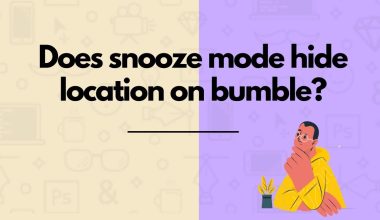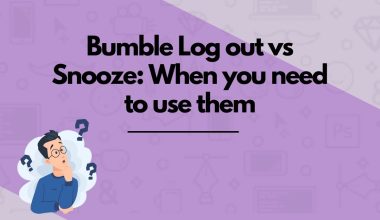As an Amazon Associate, I may earn a small commission from qualifying purchases. Learn more about this.
Table of Contents Show
Online dating apps like Bumble have revolutionized the way people connect and form relationships.
For a dating app like Bumble, one of its key features is the use of location data to help users find potential matches in their area, which has been awesome, no doubt.
But have you ever wondered how accurate this is?
Well, let’s explore that in this article.
How accurate is Bumble’s location?
When it comes to online dating, location is everything.
After all, what good is a potential match if they live on the other side of the country? That’s why it’s so important for dating apps like Bumble to have accurate location tracking.
But just how accurate is Bumble’s location data?

The short answer is: it depends.
Bumble uses a combination of GPS, WiFi, and cell tower data to track your location, and the accuracy of this data can vary based on several factors.
For example, if you’re in an area with poor cell coverage, Bumble may struggle to accurately pinpoint your location.
Similarly, if you’re using an older device with outdated GPS hardware, Bumble may have a harder time tracking you.
That being said, Bumble’s location tracking is generally quite accurate.
According to the company’s website, their location data is accurate to within 50-100 feet in most cases.
This level of accuracy should be more than sufficient for most users to find potential matches in their area.
Of course, no location tracking system is perfect, and bumbles are no exception.
Several factors can impact the accuracy of Bumble’s location data, including environmental factors like weather and interference from other wireless signals.
Additionally, if you’re using a VPN or other privacy tools, this can sometimes interfere with Bumble’s ability to track your location.
Despite these limitations, however, Bumble’s location tracking is generally quite reliable.
As long as you’re in an area with decent cell coverage and using a relatively modern device, you should be able to trust Bumble’s location data to help you find matches in your area.
Lastly, Apps do get glitches. Bumble is not an exception. For instance, we’ve seen people complaining about the inability of the app to show distance in some cases, and even keep changing the distance of users by a mile.
So, yeah, these things do count.
Lastly, if you were referring to the Lives in feature, as shown in this picture….

Then, that’s not accurate.
You can read more on the comparison between the Lives in and Bumble location feature
How does Bumble determine your location?
Bumble uses a variety of technologies to track your location, including GPS, WiFi, and cell tower data.
When you open the app, Bumble will use these technologies to determine your approximate location, which it will then use to show you potential matches in your area.
GPS is perhaps the most well-known of these location-tracking technologies.
It uses satellites to determine your precise location, which Bumble can then use to show you matches that are within a certain distance from you.
However, GPS can be impacted by several factors, including weather, tall buildings, and other environmental factors, which can sometimes result in inaccurate location data.
To supplement GPS data, Bumble also uses WiFi and cell tower data to track your location.
These technologies are less precise than GPS, but they can be useful in areas where GPS signals are weak or blocked.
When you connect to a WiFi network or cell tower, Bumble can use this data to approximate your location and show you potential matches in your area.
In terms of how frequently Bumble updates your location, this can vary based on several factors. Generally speaking, Bumble will update your location whenever you open the app or make changes to your profile.
However, if you have location services turned off, Bumble may not be able to update your location at all.
Despite the various technologies that Bumble uses to track your location, there are still potential sources of error or inaccuracy.
For example, if you’re in an area with poor cell coverage, Bumble may struggle to accurately pinpoint your location.
Similarly, if you’re using an older device with outdated GPS hardware, Bumble may have a harder time tracking you.
It’s also worth noting that if you’re using a VPN or other privacy tools, this can sometimes interfere with Bumble’s ability to track your location. As a result, could make the app show you people that are far away in respect to your location.
Overall, Bumble’s use of multiple location tracking technologies helps to ensure that the app can provide accurate location data to users.
However, as with any location tracking system, there are potential sources of error or inaccuracy that users should be aware of.
How do Bumble’s location settings impact accuracy?
Bumble offers users two options for setting their location: manual location selection or automatic location tracking based on the device’s GPS. While both options have their benefits, they can also impact the accuracy of your location on the app in different ways.
Manual location selection
If you choose to manually select your location on Bumble, you’ll be prompted to enter your desired location in the app.
This can be helpful if you’re looking to match with people in a specific area, or if you’re travelling and want to see potential matches in a different location.
However, manual location selection can also result in inaccuracies if you’re not careful.
For example, if you’re in a different location than the one you’ve manually entered, Bumble may still show you potential matches in your selected location.
This can be frustrating for both you and your potential matches, as you may not be available to meet up in the location that you’ve selected.
Automatic location tracking
Bumble’s default setting is to track your location automatically using your device’s GPS.
This can be convenient if you’re not sure where you are or if you’re frequently on the move. However, automatic location tracking can also result in inaccuracies if your device’s GPS is not functioning properly.
Additionally, if you have location services turned off or if you’re using a device with outdated GPS hardware, Bumble may struggle to accurately track your location.
This can result in matches that are not actually in your area, which can be frustrating for both you and your potential matches.
Overall, the choice between manual location selection and automatic location tracking will depend on your personal preferences and needs. While manual location selection can be helpful in certain situations, automatic location tracking is generally more reliable and less prone to inaccuracies.
Regardless of which option you choose, it’s important to keep in mind that there are potential sources of error and inaccuracy that can impact the accuracy of your location on Bumble.
Conclusion
Bumble’s location tracking is generally reliable, but there are still potential sources of error or inaccuracy that can impact your matches and overall experience on the app.
Ultimately, whether you’re using Bumble or any other dating app, it’s important to keep in mind that location accuracy is just one piece of the puzzle when it comes to online dating.










